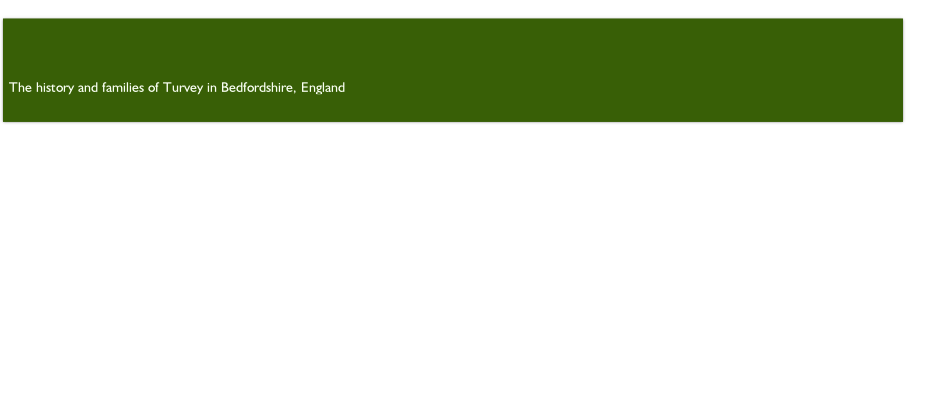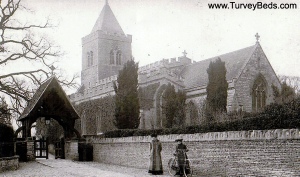
©2011 Deborah Richardson

Privacy Policy
Copyright

Turvey in 1890
An Aussie Visits Turvey - 1890
Here is a transcription on the account of a visit to England and US which was written by Isaac Roff (1819 - 1892) a son of Joseph Roff and Sarah Howe of Bedford, apprenticed as a tailor at Kimbolton, who went to London and became a foreman tailor and emigrated to Australia in the early 1850's.
He and his brother Joseph (1825 - 1894), who had been apprenticed at Hatfield, and had also come to Australia, undertook a return visit to England in 1890. Both brothers wrote accounts of their visit - Isaac's is by far the more comprehensive, and was published in pamphlet form. Here is the section where he describes his visit to Turvey, in June-July 1890:
"Another day paid a visit to an old-
Several large and noble tombs are inside the church, four or five feet high, with life size figures at top. One of these
shows the figures of the ancestors of the celebrated Lady Mordant, of whom we heard so much of some time ago. The largest of the tombs and they are all a good size had Lord Mordant and his two wives. The first was on his right side, and the second on his left, whilst he was raised about nine inches higher than them all, being full size, and at full length on their backs. They were well cut figures, Lord Mordant having his armour on, his
Several large and noble tombs are inside the church, four or five feet high, with life size figures at top. One of these
shows the figures of the ancestors of the celebrated Lady Mordant, of whom we heard so much of some time ago. The largest of the tombs and they are all a good size had Lord Mordant and his two wives. The first was on his right side, and the second on his left, whilst he was raised about nine inches higher than them all, being full size, and at full length on their backs. They were well cut figures, Lord Mordant having his armour on, his
helmet at side of head, the ladies in the costume of the day.
This is a very attractive church, and well kept by the noblemen of the time. There are six bells in the belfry, and I was up amongst them. The place is very clean, like Old Warden spoken of above. The church was built in the tenth century.
It appears that a little short of two hundred years ago my great great grandfather kept "The Three Fishes" here, and old fashioned place now. I never heard of any relation of mine being a licensed victualler before this day, when my elder brother told me. Since his day, the town has moved a bit, and another inn was built in the more flourishing part, called "The Three Cranes." It is said that "The Three Cranes swallowed "The Three Fishes," hence the decay of the latter.
At the side of "The Three Fishes" is a large pond of water and a flour mill. In the middle of the pond is a statue of Jonah with his knee on the head of a whale, the
This is a very attractive church, and well kept by the noblemen of the time. There are six bells in the belfry, and I was up amongst them. The place is very clean, like Old Warden spoken of above. The church was built in the tenth century.
It appears that a little short of two hundred years ago my great great grandfather kept "The Three Fishes" here, and old fashioned place now. I never heard of any relation of mine being a licensed victualler before this day, when my elder brother told me. Since his day, the town has moved a bit, and another inn was built in the more flourishing part, called "The Three Cranes." It is said that "The Three Cranes swallowed "The Three Fishes," hence the decay of the latter.
At the side of "The Three Fishes" is a large pond of water and a flour mill. In the middle of the pond is a statue of Jonah with his knee on the head of a whale, the
latter having his mouth open and big tongue out. This inn was noted years back, and the minister (the church is very near) used regularly on Sunday to get his dinner here. He would pull off his gown, pulling bread and cheese from his pocket, call for a pint of beer, sit in the porch and eat and rink, and sometimes call for a second pint. This old inn is very uneven, with the same flagstones that were put down for the floor when the building was first erected, and everything looks gone to decay, but yet strong. The inn is supposed to be fully three hundred years old.
The drive to this place, and the place itself, with the bread and cheese at the old inn, which we paid our respects to, in order to keep up the old parsonified charter, together with the drive back, between the fields of wheat, barley and other grain, just ripening, was a treat to one who had been shut up in Melbourne so long. But no matter where we took a drive in Bedfordshire at this season of harvest time it was delightful."
The drive to this place, and the place itself, with the bread and cheese at the old inn, which we paid our respects to, in order to keep up the old parsonified charter, together with the drive back, between the fields of wheat, barley and other grain, just ripening, was a treat to one who had been shut up in Melbourne so long. But no matter where we took a drive in Bedfordshire at this season of harvest time it was delightful."
This account was kindly sent to me by
Peter Freund,
Publicist & Theatre Historian of Her Majesty's Theatre in Ballarat,Victoria, Australia.
Thank you very much.
